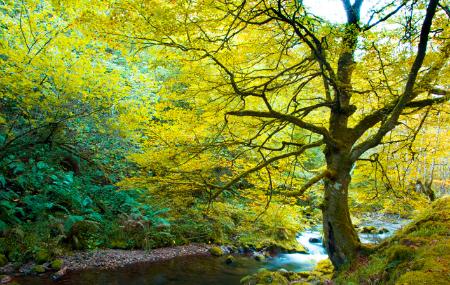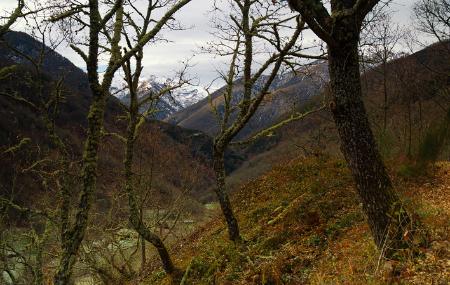
- Title Cangas del Narcea e ibias Western Asturias
- Extension Extension: 55 km 2
- Open to the public Open to the public: All year round
- Maximum elevation Maximum elevation: 1680 m
It includes the Munieḷḷos and La Vilieḷḷḷa mountains (Cangas del Narcea) and the Valdebois mountain (Ibias). The Muniellos Forest, the largest oak forest in Spain and one of the best preserved in Europe, is home to a true virgin nature that is reborn every season with surprising examples of its adaptation to the environment. Always changing, it is a clear example of the Asturian paradise at all times of the year. Oaks of different species and up to six metres in diameter, beech and birch trees are dotted with the continuous presence of holly and yew trees, the perennial kings of the Muniellos autumn.
How to prepare your visit to Muniellos
This fantastic forest, full of legends and Asturian mythology, sits on a Palaeozoic substratum some 500 million years old; here you can see ancient glacial cirques and lleronas, crumbled quartzite cliffs. The glacial origin of Muniellos is attested by the famous lagoons of the Pico de la Candanosa, four steps of water, of enigmatic beauty, which are hidden among valleys, paths and peaks. The ascent to these lakes: La Peña, Grande, Fonda and La Isla is one of the most interesting routes for hiking enthusiasts.
The river Muniellos or Tablizas, a tributary of the Narcea, flows through the forest, collecting the waters of the numerous streams that flow torrentially along its sides. The climate is typically mountainous, with a high rainfall of around 1,800 litres per square metre, and a temperature of 10ºC in the mid-mountains and below 6ºC in the summit region. Snow is frequent during the cold season, and snow remains for a large part of the winter in the highest areas.
In order to preserve its exceptional condition, visits are restricted to groups of twenty people per day, and must be booked in advance on the official website of the Government of the Principality of Asturias: www.asturias.es
Plant life
Another of the fascinating secrets of Muniellos is its great variety of fungi and mushrooms, most of them edible, which sow the forests with more than four hundred species. The plants take advantage of any lack of attention from the winter sun to produce their intensely coloured fruits. Almost four hundred different species, some of which form part of the catalogue of Threatened Species of the Flora of the Principality of Asturias.
Wildlife
Animal lovers have in the Muniellos Forest an important reference point for Asturian fauna. Abundant, varied and elusive, it hides in the depths of the forest, fleeing from human presence. The most relevant is the Cantabrian brown bear, which finds the right conditions for its development and survival in the area. The wolf populates the mountains with stable breeding areas and the presence of family groups, feeding on other animals that inhabit the mountains, such as wild boar and roe deer. It is possible to observe the moulting of the fox's fur in autumn, when squirrels, jays and grouse change their spring diet for the abundant fruits that fill the forest: blueberries, blackberries, hazelnuts and acorns.
Located in the south-west of Asturias, between the councils of Ibias and Cangas del Narcea.
Pets are not allowed.
More information:
- Muniellos Interpretation Centre. Between Oubachu and Mual (Cangas del Narcea).
- Muniellos Visitor Reception Centre. Las Tablizas (Cangas del Narcea).
Citizen's Advice Service (SAC)
Telephone: 985 279 100
Cangas del Narcea Tourist Office
Telephone: 985 811 498




